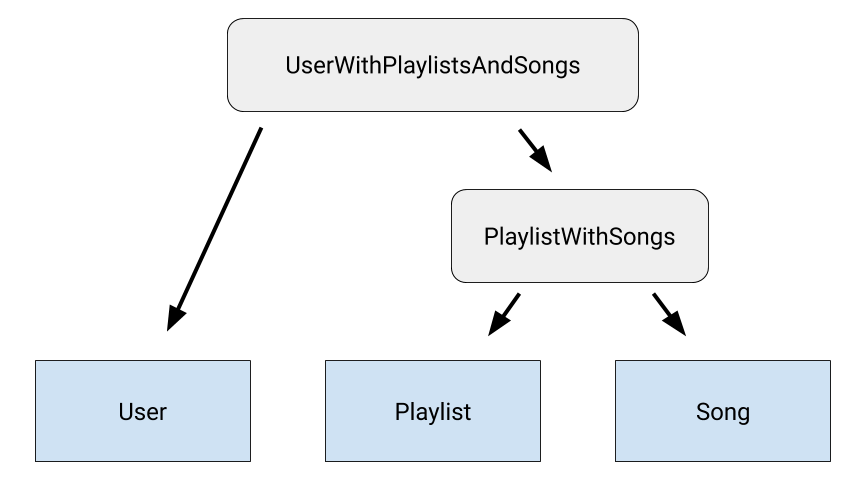Đôi khi, bạn cần truy vấn một tập hợp gồm ba bảng trở lên và tất cả đều liên quan đến nhau. Trong trường hợp đó, bạn sẽ xác định mối quan hệ lồng ghép giữa các bảng.
Giả sử trong ví dụ về ứng dụng phát nhạc trực tuyến, bạn muốn truy vấn tất cả người dùng, danh sách phát của mỗi người dùng và tất cả bài hát trong từng danh sách phát của từng người dùng. Người dùng có mối quan hệ một với nhiều với danh sách phát và danh sách phát có mối quan hệ nhiều với nhiều với bài hát. Mã ví dụ sau đây hiển thị các lớp đại diện cho các thực thể này, cũng như bảng tham chiếu chéo cho mối quan hệ nhiều với nhiều giữa danh sách phát và bài hát:
Kotlin
@Entity
data class User(
@PrimaryKey val userId: Long,
val name: String,
val age: Int
)
@Entity
data class Playlist(
@PrimaryKey val playlistId: Long,
val userCreatorId: Long,
val playlistName: String
)
@Entity
data class Song(
@PrimaryKey val songId: Long,
val songName: String,
val artist: String
)
@Entity(primaryKeys = ["playlistId", "songId"])
data class PlaylistSongCrossRef(
val playlistId: Long,
val songId: Long
)
Java
@Entity
public class User {
@PrimaryKey public long userId;
public String name;
public int age;
}
@Entity
public class Playlist {
@PrimaryKey public long playlistId;
public long userCreatorId;
public String playlistName;
}
@Entity
public class Song {
@PrimaryKey public long songId;
public String songName;
public String artist;
}
@Entity(primaryKeys = {"playlistId", "songId"})
public class PlaylistSongCrossRef {
public long playlistId;
public long songId;
}
Trước tiên, hãy mô hình hoá mối quan hệ giữa hai bảng trong tập hợp của bạn như bình thường, sử dụng lớp dữ liệu và chú giải @Relation. Ví dụ sau đây hiển thị một lớp PlaylistWithSongs mà mô hình hoá mối quan hệ nhiều với nhiều giữa lớp thực thể Playlist và lớp thực thể Song:
Kotlin
data class PlaylistWithSongs(
@Embedded val playlist: Playlist,
@Relation(
parentColumn = "playlistId",
entityColumn = "songId",
associateBy = Junction(PlaylistSongCrossRef::class)
)
val songs: List<Song>
)
Java
public class PlaylistWithSongs {
@Embedded public Playlist playlist;
@Relation(
parentColumn = "playlistId",
entityColumn = "songId",
associateBy = Junction(PlaylistSongCrossRef.class)
)
public List<Song> songs;
}
Sau khi xác định một lớp dữ liệu đại diện cho mối quan hệ này, hãy tạo một lớp dữ liệu khác mà mô hình hoá mối quan hệ giữa một bảng khác từ tập hợp của bạn và lớp mối quan hệ đầu tiên, "lồng" mối quan hệ hiện có vào trong mối quan hệ mới. Ví dụ sau đây hiển thị một lớp UserWithPlaylistsAndSongs mà mô hình hoá mối quan hệ một với nhiều giữa lớp thực thể User và lớp mối quan hệ PlaylistWithSongs:
Kotlin
data class UserWithPlaylistsAndSongs(
@Embedded val user: User
@Relation(
entity = Playlist::class,
parentColumn = "userId",
entityColumn = "userCreatorId"
)
val playlists: List<PlaylistWithSongs>
)
Java
public class UserWithPlaylistsAndSongs {
@Embedded public User user;
@Relation(
entity = Playlist.class,
parentColumn = "userId",
entityColumn = "userCreatorId"
)
public List<PlaylistWithSongs> playlists;
}
Lớp UserWithPlaylistsAndSongs gián tiếp mô hình hoá mối quan hệ giữa cả ba lớp thực thể: User, Playlist và Song. Điều này được minh hoạ trong hình 1.

Nếu còn bất kỳ bảng nào khác trong tập hợp của bạn, tạo một lớp để mô hình hoá mối quan hệ giữa từng bảng còn lại và lớp mối quan hệ mà mô hình hoá mối quan hệ giữa tất cả các bảng trước đó. Điều này tạo ra một chuỗi các mối quan hệ lồng ghép giữa tất cả các bảng bạn muốn truy vấn.
Cuối cùng, hãy thêm một phương thức vào lớp DAO để hiển thị hàm truy vấn mà ứng dụng của bạn cần. Phương thức này đòi hỏi Room chạy nhiều truy vấn. Vì vậy, hãy thêm chú thích @Transaction để đảm bảo rằng toàn bộ thao tác sẽ được thực hiện tỷ mỷ:
Kotlin
@Transaction
@Query("SELECT * FROM User")
fun getUsersWithPlaylistsAndSongs(): List<UserWithPlaylistsAndSongs>
Java
@Transaction
@Query("SELECT * FROM User")
public List<UserWithPlaylistsAndSongs> getUsersWithPlaylistsAndSongs();

